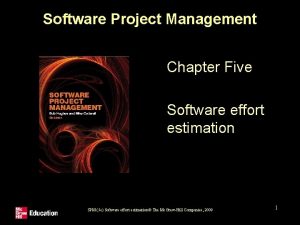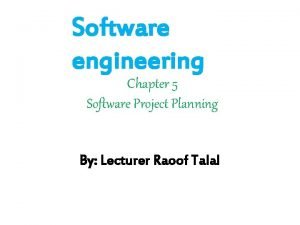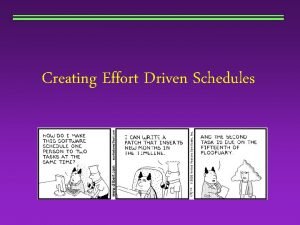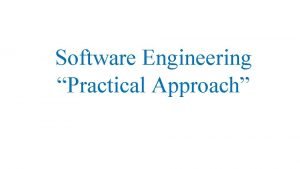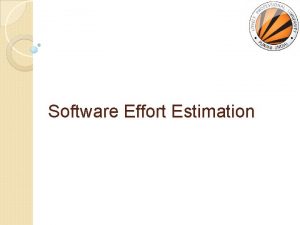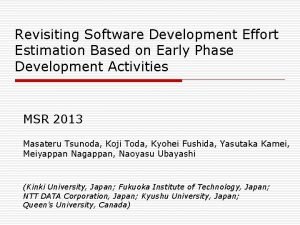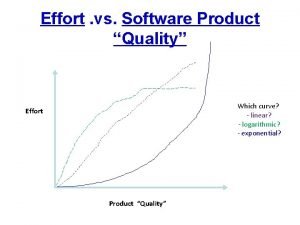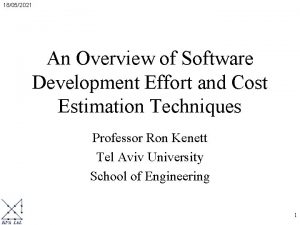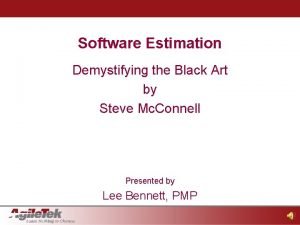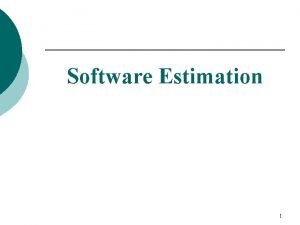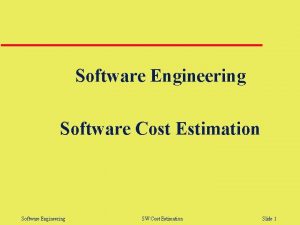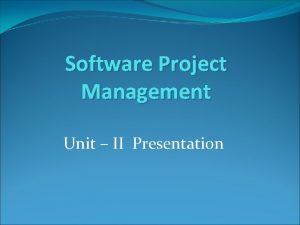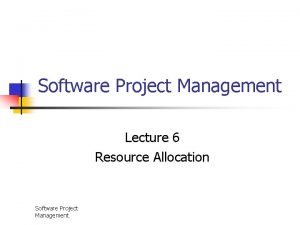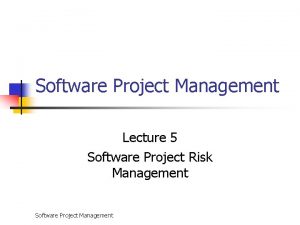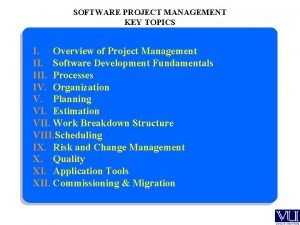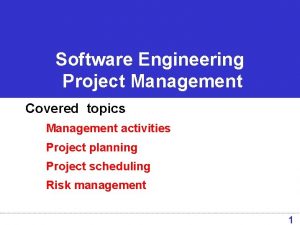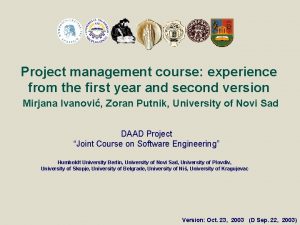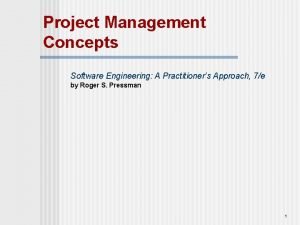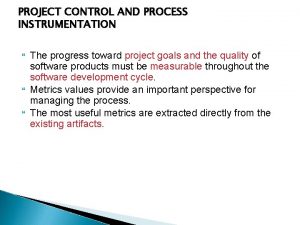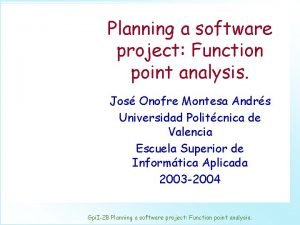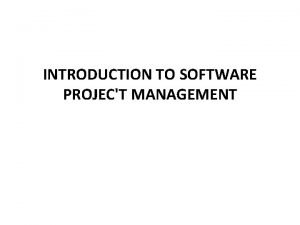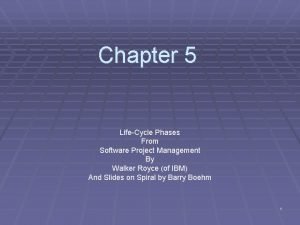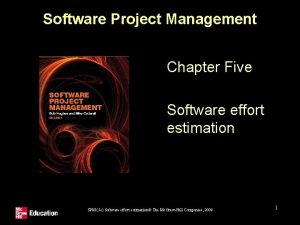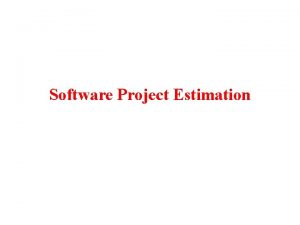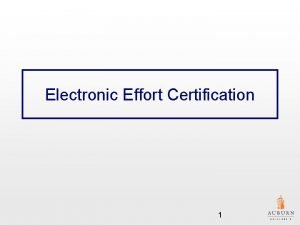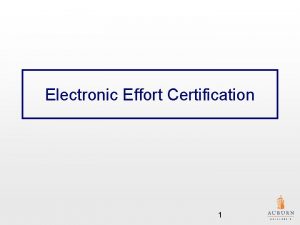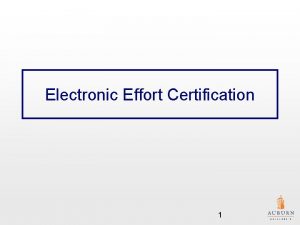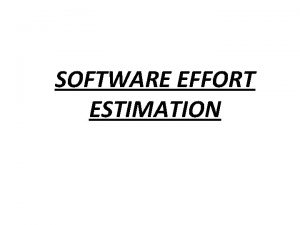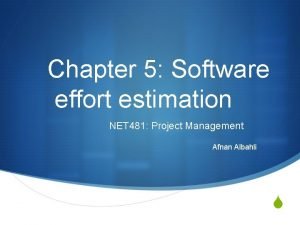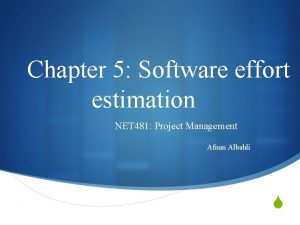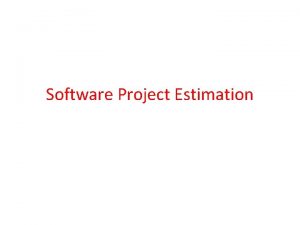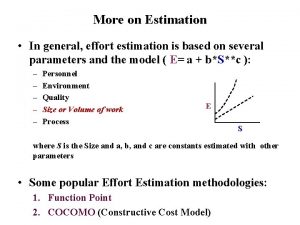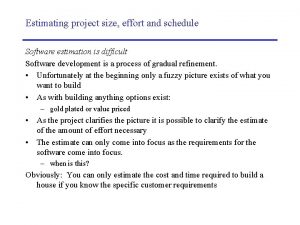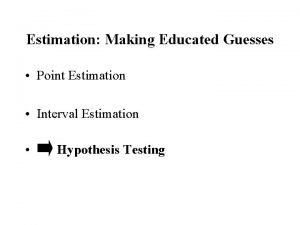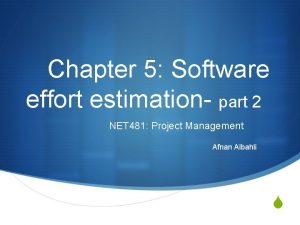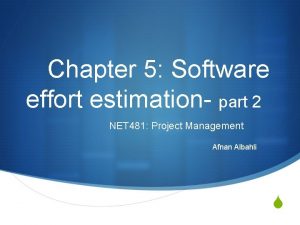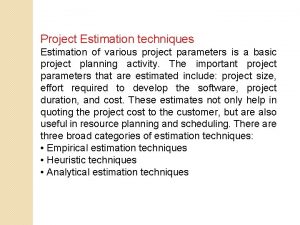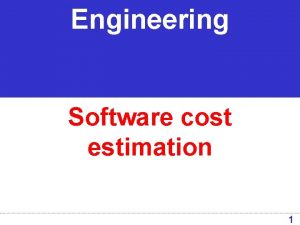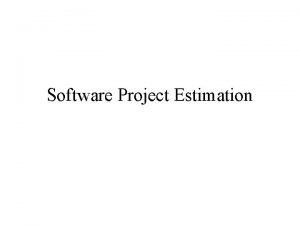Software Project Management Chapter Five Software effort estimation











































- Slides: 43

Software Project Management Chapter Five Software effort estimation SPM (5 e) Software effort estimation© The Mc. Graw-Hill Companies, 2009 1

What makes a successful project? Delivering: l agreed functionality l on time l at the agreed cost l with the required quality Stages: 1. set targets 2. Attempt to achieve targets BUT what if the targets are not achievable? SPM (5 e) Software effort estimation© The Mc. Graw-Hill Companies, 2009 2

Some problems with estimating Subjective nature of much of estimating It may be difficult to produce evidence to support your precise target Political pressures Managers may wish to reduce estimated costs in order to win support for acceptance of a project proposal Changing technologies these bring uncertainties, especially in the early days when there is a ‘learning curve’ Projects differ Experience on one project may not be applicable to another SPM (5 e) Software effort estimation© The Mc. Graw-Hill Companies, 2009 3

Over and under-estimating Parkinson’s Law: ‘Work expands to fill the time available’ An over-estimate is likely to cause project to take longer than it would otherwise Weinberg’s Zeroth Law of reliability: ‘a software project that does not have to meet a reliability requirement can meet any other requirement’ SPM (5 e) Software effort estimation© The Mc. Graw-Hill Companies, 2009 4

Basis for successful estimating Information about past projects Need to collect performance details about past project: how big were they? How much effort/time did they need? Need to be able to measure the amount of work involved Traditional size measurement for software is ‘lines of code’ – but this can have problems SPM (5 e) Software effort estimation© The Mc. Graw-Hill Companies, 2009 5

A taxonomy of estimating methods Bottom-up - activity based, analytical Parametric or algorithmic models e. g. function points Expert opinion - just guessing? Analogy - case-based, comparative Parkinson and ‘price to win’ SPM (5 e) Software effort estimation© The Mc. Graw-Hill Companies, 2009 6

Bottom-up versus top-down Bottom-up use when no past project data identify all tasks that have to be done – so quite timeconsuming use when you have no data about similar past projects Top-down produce overall estimate based on project cost drivers based on past project data divide overall estimate between jobs to be done SPM (5 e) Software effort estimation© The Mc. Graw-Hill Companies, 2009 7

Bottom-up estimating 1. Break project into smaller and smaller components [2. Stop when you get to what one person can do in one/two weeks] 3. Estimate costs for the lowest level activities 4. At each higher level calculate estimate by adding estimates for lower levels SPM (5 e) Software effort estimation© The Mc. Graw-Hill Companies, 2009 8

Top-down estimates Estimate overall 100 days project design code test 30% i. e. 30 days 40% i. e. 40 days Produce overall estimate using effort driver(s) distribute proportions of overall estimate to components SPM (5 e) Software effort estimation© The Mc. Graw-Hill Companies, 2009 9

Algorithmic/Parametric models COCOMO (lines of code) and function points examples of these Problem with COCOMO etc: algorithm guess estimate but what is desired is system characteristic algorithm SPM (5 e) Software effort estimation© The Mc. Graw-Hill Companies, 2009 estimate 10

Parametric models - the need for historical data simplistic model for an estimated effort = (system size) / productivity e. g. system size = lines of code productivity = lines of code per day productivity = (system size) / effort based on past projects SPM (5 e) Software effort estimation© The Mc. Graw-Hill Companies, 2009 11

Parametric models Some models focus on task or system size e. g. Function Points FPs originally used to estimate Lines of Code, rather than effort Number of file types model ‘system size’ Numbers of input and output transaction types SPM (5 e) Software effort estimation© The Mc. Graw-Hill Companies, 2009 12

Parametric models Other models focus on productivity: e. g. COCOMO Lines of code (or FPs etc) an input System size Estimated effort Productivity factors SPM (5 e) Software effort estimation© The Mc. Graw-Hill Companies, 2009 13

Expert judgement Asking someone who is familiar with and knowledgeable about the application area and the technologies to provide an estimate Particularly appropriate where existing code is to be modified Research shows that experts judgement in practice tends to be based on analogy SPM (5 e) Software effort estimation© The Mc. Graw-Hill Companies, 2009 14

Estimating by analogy source cases attribute values effort attribute values effort Use effort from source as estimate target case attribute values ? ? ? Select case with closet attribute values SPM (5 e) Software effort estimation© The Mc. Graw-Hill Companies, 2009 15

Stages: identify Significant features of the current project previous project(s) with similar features differences between the current and previous projects possible reasons for error (risk) measures to reduce uncertainty SPM (5 e) Software effort estimation© The Mc. Graw-Hill Companies, 2009 16

Machine assistance for source selection (ANGEL) Number of inputs Source A Source B It-Is Ot-Os target Number of outputs Euclidean distance = sq root ((It - Is)2 + (Ot - Os)2 ) SPM (5 e) Software effort estimation© The Mc. Graw-Hill Companies, 2009 17

Parametric models We are now looking more closely at four parametric models: 1. Albrecht/IFPUG function points 2. Symons/Mark II function points 3. COSMIC function points 4. COCOMO 81 and COCOMO II SPM (5 e) Software effort estimation© The Mc. Graw-Hill Companies, 2009 18

Albrecht/IFPUG function points Albrecht worked at IBM and needed a way of measuring the relative productivity of different programming languages. Needed some way of measuring the size of an application without counting lines of code. Identified five types of component or functionality in an information system Counted occurrences of each type of functionality in order to get an indication of the size of an information system SPM (5 e) Software effort estimation© The Mc. Graw-Hill Companies, 2009 19

Albrecht/IFPUG function points continued Five function types 1. Logical interface file (LIF) types – equates roughly to a datastore in systems analysis terms. Created and accessed by the target system 2. External interface file types (EIF) – where data is retrieved from a datastore which is actually maintained by a different application. SPM (5 e) Software effort estimation© The Mc. Graw-Hill Companies, 2009 20

Albrecht/IFPUG function points continued 3. 4. 5. External input (EI) types – input transactions which update internal computer files External output (EO) types – transactions which extract and display data from internal computer files. Generally involves creating reports. External inquiry (EQ) types – user initiated transactions which provide information but do not update computer files. Normally the user inputs some data that guides the system to the information the user needs. SPM (5 e) Software effort estimation© The Mc. Graw-Hill Companies, 2009 21

Albrecht complexity multipliers External user types Low complexity Medium complexity High complexity EI 3 4 6 EO 4 5 7 EQ 3 4 6 LIF 7 10 15 EIF 5 7 10 SPM (5 e) Software effort estimation© The Mc. Graw-Hill Companies, 2009 22

Examples Payroll application has: 1. Transaction to input, amend and delete employee details – an EI that is rated of medium complexity 2. A transaction that calculates pay details from timesheet data that is input – an EI of high complexity 3. A transaction of medium complexity that prints out pay-to -date details for each employee – EO 4. A file of payroll details for each employee – assessed as of medium complexity LIF 5. A personnel file maintained by another system is accessed for name and address details – a simple EIF What would be the FP counts for these? SPM (5 e) Software effort estimation© The Mc. Graw-Hill Companies, 2009 23

FP counts 4 FPs 2. 6 FPs 3. 5 FPs 4. 10 FPs 5. 5 FPs Total 30 FPs If previous projects delivered 5 FPs a day, implementing the above should take 30/5 = 6 days 1. Medium EI High complexity EI Medium complexity EO Medium complexity LIF Simple EIF SPM (5 e) Software effort estimation© The Mc. Graw-Hill Companies, 2009 24

Function points Mark II Developed by Charles R. Symons ‘Software sizing and estimating - Mk II FPA’, Wiley & Sons, 1991. Builds on work by Albrecht Work originally for CCTA: should be compatible with SSADM; mainly used in UK has developed in parallel to IFPUG FPs A simpler method SPM (5 e) Software effort estimation© The Mc. Graw-Hill Companies, 2009 25

Function points Mk II continued #entities accessed #input items For each transaction, count data items input (Ni) data items output (No) entity types accessed (Ne) #output items FP count = Ni * 0. 58 + Ne * 1. 66 + No * 0. 26 SPM (5 e) Software effort estimation© The Mc. Graw-Hill Companies, 2009 26

Function points for embedded systems Mark II function points, IFPUG function points were designed for information systems environments COSMIC FPs attempt to extend concept to embedded systems Embedded software seen as being in a particular ‘layer’ in the system Communicates with other layers and also other components at same level SPM (5 e) Software effort estimation© The Mc. Graw-Hill Companies, 2009 27

Layered software Higher layers Receives request Supplies service Peer to peer Data reads/ communication writes Persistent peer Software component storage component Makes a request for a service Receives service Lower layers SPM (5 e) Software effort estimation© The Mc. Graw-Hill Companies, 2009 28

COSMIC FPs The following are counted: Entries: movement of data into software component from a higher layer or a peer component Exits: movements of data out Reads: data movement from persistent storage Writes: data movement to persistent storage Each counts as 1 ‘COSMIC functional size unit’ (Cfsu) SPM (5 e) Software effort estimation© The Mc. Graw-Hill Companies, 2009 29

COCOMO 81 Based on industry productivity standards - database is constantly updated Allows an organization to benchmark its software development productivity Basic model effort = c x sizek C and k depend on the type of system: organic, semidetached, embedded Size is measured in ‘kloc’ ie. Thousands of lines of code SPM (5 e) Software effort estimation© The Mc. Graw-Hill Companies, 2009 30

The COCOMO constants System type c k Organic (broadly, information systems) 2. 4 1. 05 Semi-detached 3. 0 1. 12 Embedded (broadly, realtime) 3. 6 1. 20 k exponentiation – ‘to the power of…’ adds disproportionately more effort to the larger projects takes account of bigger management overheads SPM (5 e) Software effort estimation© The Mc. Graw-Hill Companies, 2009 31

Development effort multipliers (dem) According to COCOMO, the major productivity drivers include: Product attributes: required reliability, database size, product complexity Computer attributes: execution time constraints, storage constraints, virtual machine (VM) volatility Personnel attributes: analyst capability, application experience, VM experience, programming language experience Project attributes: modern programming practices, software tools, schedule constraints SPM (5 e) Software effort estimation© The Mc. Graw-Hill Companies, 2009 32

Using COCOMO development effort multipliers (dem) An example: for analyst capability: Assess capability as very low, nominal, high or very high Extract multiplier: very low 1. 46 low 1. 19 nominal 1. 00 high 0. 80 very high 0. 71 Adjust nominal estimate e. g. 32. 6 x 0. 80 = 26. 8 staff months SPM (5 e) Software effort estimation© The Mc. Graw-Hill Companies, 2009 33

COCOMO II An updated version of COCOMO: There are different COCOMO II models for estimating at the ‘early design’ stage and the ‘post architecture’ stage when the final system is implemented. We’ll look specifically at the first. The core model is: pm = A(size)(sf) ×(em 1) ×(em 2) ×(em 3)…. where pm = person months, A is 2. 94, size is number of thousands of lines of code, sf is the scale factor, and em is an effort multiplier SPM (5 e) Software effort estimation© The Mc. Graw-Hill Companies, 2009 34

COCOMO II Scale factor Based on five factors which appear to be particularly sensitive to system size 1. Precedentedness (PREC). Degree to which there are past examples that can be consulted 2. Development flexibility (FLEX). Degree of flexibility that exists when implementing the project 3. Architecture/risk resolution (RESL). Degree of uncertainty about requirements 4. Team cohesion (TEAM). 5. Process maturity (PMAT) could be assessed by CMMI – see Section 13. 8 SPM (5 e) Software effort estimation© The Mc. Graw-Hill Companies, 2009 35

COCOMO II Scale factor values Driver Very low Low Nominal High Very high Extra high PREC 6. 20 4. 96 3. 72 2. 48 1. 24 0. 00 FLEX 5. 07 4. 05 3. 04 2. 03 1. 01 0. 00 RESL 7. 07 5. 65 4. 24 2. 83 1. 41 0. 00 TEAM 5. 48 4. 38 3. 29 2. 19 1. 10 0. 00 PMAT 7. 80 6. 24 4. 68 3. 12 1. 56 0. 00 SPM (5 e) Software effort estimation© The Mc. Graw-Hill Companies, 2009 36

Example of scale factor A software development team is developing an application which is very similar to previous ones it has developed. A very precise software engineering document lays down very strict requirements. PREC is very high (score 1. 24). FLEX is very low (score 5. 07). The good news is that these tight requirements are unlikely to change (RESL is high with a score 2. 83). The team is tightly knit (TEAM has high score of 2. 19), but processes are informal (so PMAT is low and scores 6. 24) SPM (5 e) Software effort estimation© The Mc. Graw-Hill Companies, 2009 37

Scale factor calculation The formula for sf is sf = B + 0. 01 × Σ scale factor values i. e. sf = 0. 91 + 0. 01 × (1. 24 + 5. 07 + 2. 83 + 2. 19 + 6. 24) = 1. 0857 If system contained 10 kloc then estimate would be 2. 94 x 101. 0857 = 35. 8 person months Using exponentiation (‘to the power of’) adds disproportionately more to the estimates for larger applications SPM (5 e) Software effort estimation© The Mc. Graw-Hill Companies, 2009 38

Effort multipliers As well as the scale factor effort multipliers are also assessed: RCPX Product reliability and complexity RUSE Reuse required PDIF Platform difficulty PERS Personnel capability FCIL Facilities available SCED Schedule pressure SPM (5 e) Software effort estimation© The Mc. Graw-Hill Companies, 2009 39

Effort multipliers Extra low Very low Low Nom-inal High Very high Extra high 0. 49 0. 83 1. 00 1. 33 1. 91 2. 72 RUSE 0. 95 1. 00 1. 07 1. 15 1. 24 PDIF 0. 87 1. 00 1. 29 1. 81 2. 61 RCPX 0. 60 PERS 2. 12 1. 62 1. 26 1. 00 0. 83 0. 63 0. 50 PREX 1. 59 1. 33 1. 12 1. 00 0. 87 0. 74 0. 62 FCIL 1. 43 1. 30 1. 10 1. 00 0. 87 0. 73 0. 62 1. 43 1. 14 1. 00 SCED SPM (5 e) Software effort estimation© The Mc. Graw-Hill Companies, 2009 40

Example Say that a new project is similar in most characteristics to those that an organization has been dealing for some time except the software to be produced is exceptionally complex and will be used in a safety critical system. The software will interface with a new operating system that is currently in beta status. To deal with this the team allocated to the job are regarded as exceptionally good, but do not have a lot of experience on this type of software. SPM (5 e) Software effort estimation© The Mc. Graw-Hill Companies, 2009 41

Example -continued RCPX very high 1. 91 PDIF very high 1. 81 PERS extra high 0. 50 PREX nominal 1. 00 All other factors are nominal Say estimate is 35. 8 person months With effort multipliers this becomes 35. 8 x 1. 91 x 1. 81 x 0. 5 = 61. 9 person months SPM (5 e) Software effort estimation© The Mc. Graw-Hill Companies, 2009 42

Some conclusions: how to review estimates Ask the following questions about an estimate What are the task size drivers? What productivity rates have been used? Is there an example of a previous project of about the same size? Are there examples of where the productivity rates used have actually been found? SPM (5 e) Software effort estimation© The Mc. Graw-Hill Companies, 2009 43
 Software effort estimation in spm
Software effort estimation in spm What is first activity in software project planning
What is first activity in software project planning Modern project profiles in spm
Modern project profiles in spm Project evaluation in software project management
Project evaluation in software project management Traditional project management vs modern project management
Traditional project management vs modern project management Peer inspections a pragmatic view
Peer inspections a pragmatic view Software configuration items
Software configuration items Ms project effort driven
Ms project effort driven Metrics for project size estimation
Metrics for project size estimation Effort distribution in software engineering
Effort distribution in software engineering Effort certification software
Effort certification software Effort certification software
Effort certification software Effort certification software
Effort certification software Effort certification software
Effort certification software Software estimation: demystifying the black art
Software estimation: demystifying the black art Software cost estimation notes
Software cost estimation notes Software estimation demystifying the black art
Software estimation demystifying the black art Loc estimation in software engineering
Loc estimation in software engineering Five years have past five summers with the length
Five years have past five summers with the length One in five challenge
One in five challenge 5 senses and 5 elements
5 senses and 5 elements Macbeth act five scene five
Macbeth act five scene five The intent of project metrics is:
The intent of project metrics is: The role of project management in achieving project success
The role of project management in achieving project success Reducing project duration
Reducing project duration Modern project management began with what project
Modern project management began with what project Types of project audit in project management
Types of project audit in project management Microsoft project agile template
Microsoft project agile template Project termination types
Project termination types Draw and describe management spectrum
Draw and describe management spectrum Cash flow forecasting in software project management
Cash flow forecasting in software project management Resource allocation in software project management
Resource allocation in software project management What is risk in software project management
What is risk in software project management Software project management topics
Software project management topics Risk management activities in software engineering
Risk management activities in software engineering 4ps of project management
4ps of project management Project management tools in software engineering
Project management tools in software engineering 4 p's of project management in software engineering
4 p's of project management in software engineering Project control and process instrumentation in spm
Project control and process instrumentation in spm Function point analysis in project management
Function point analysis in project management Software
Software Pragmatic artifacts in software project management
Pragmatic artifacts in software project management Activity based approach in software project management
Activity based approach in software project management Construction phase in software engineering
Construction phase in software engineering
